The University of Oxford Oxford is a unique
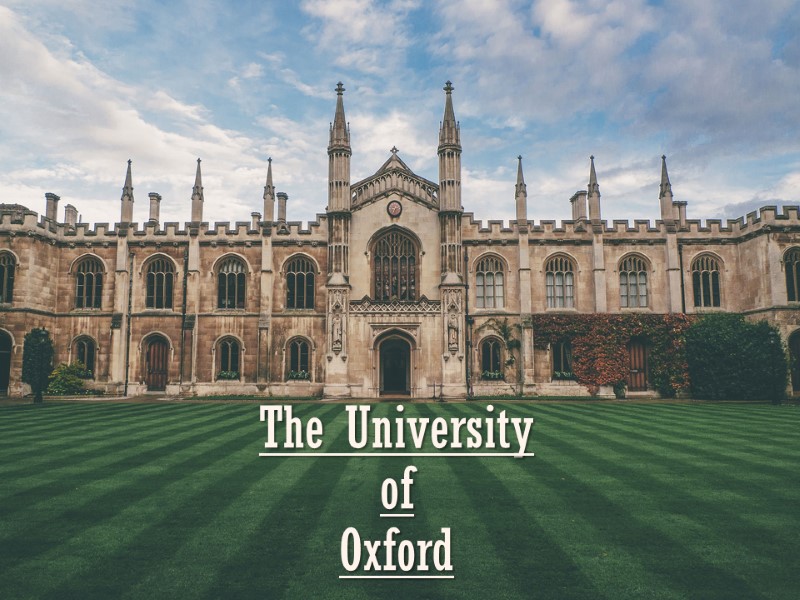
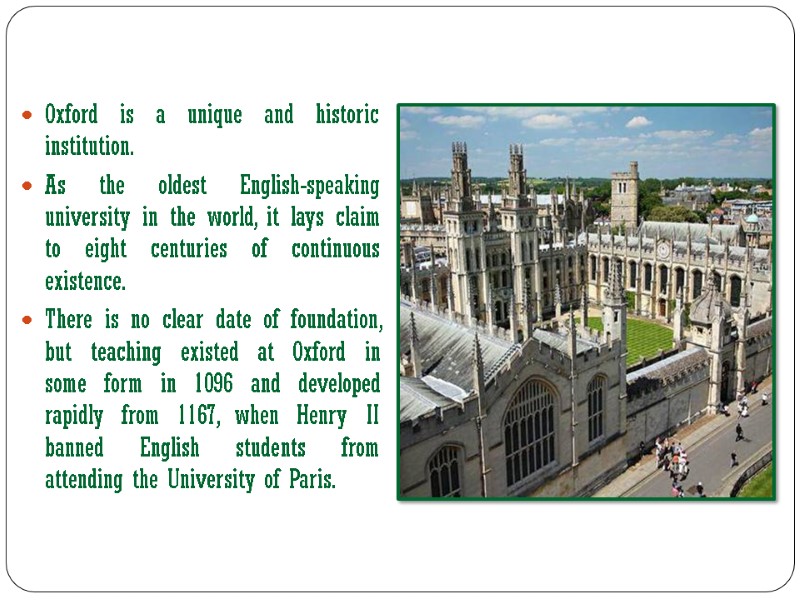
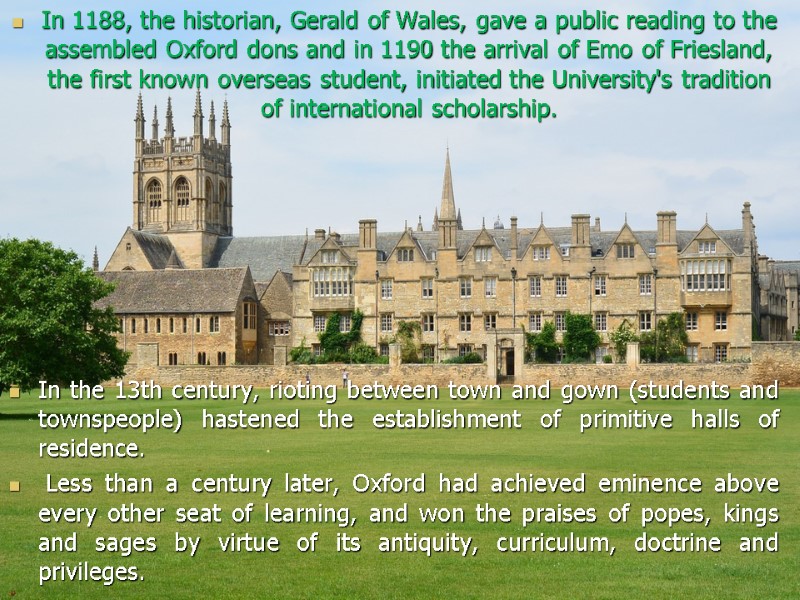
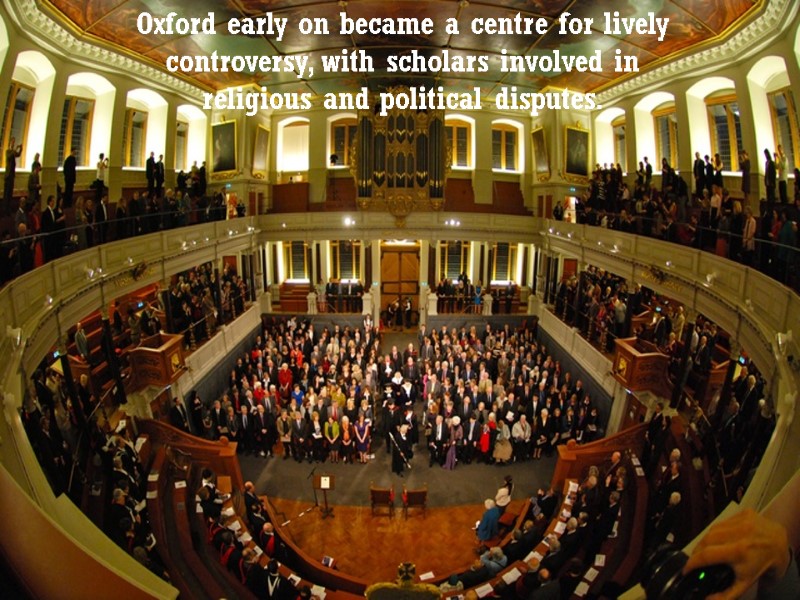
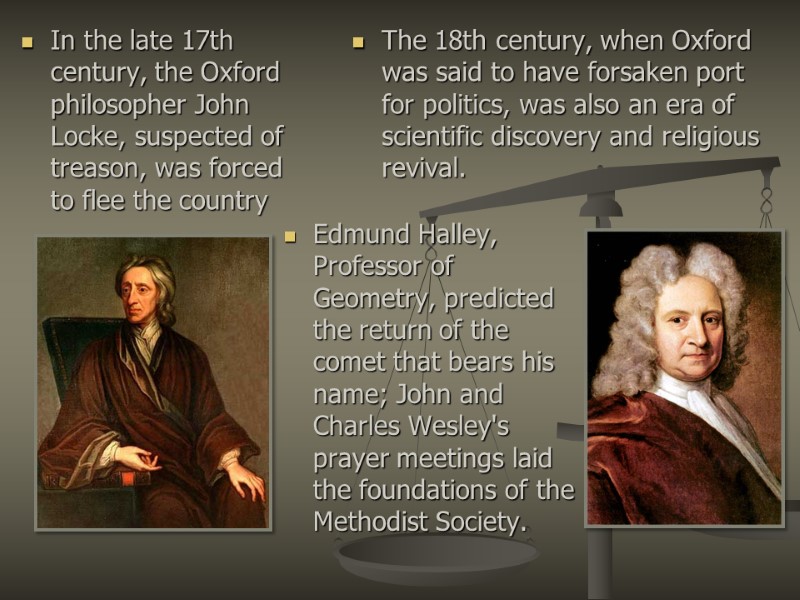
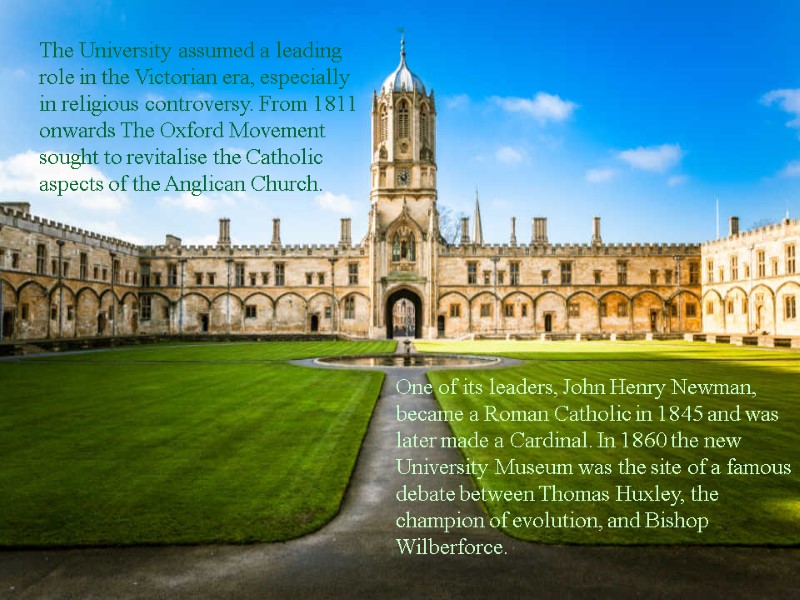
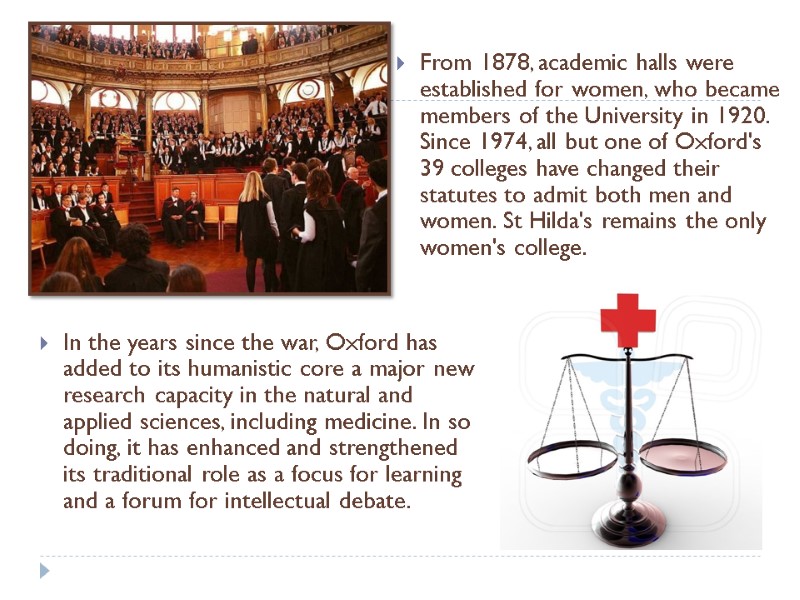
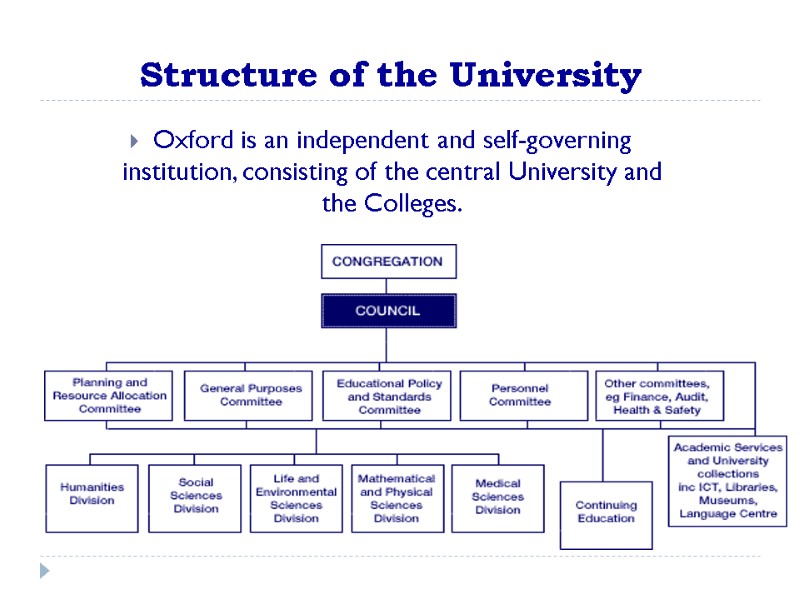
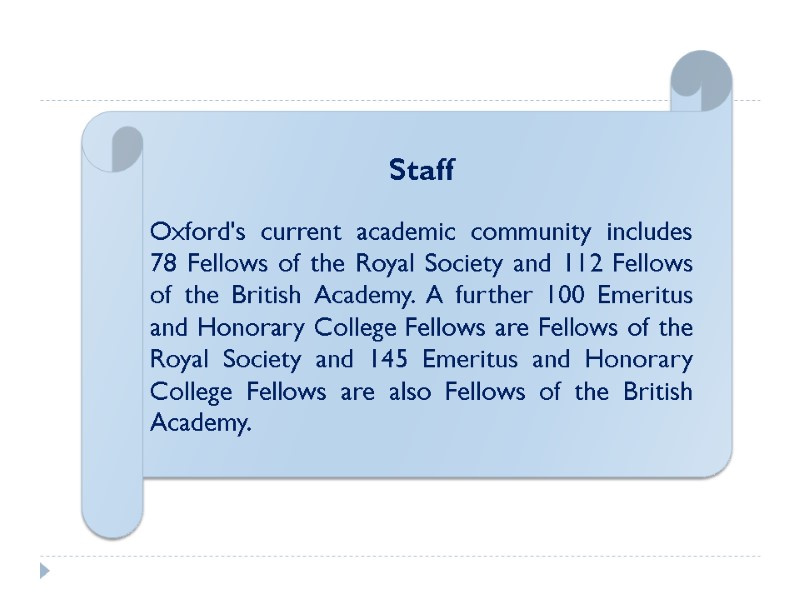
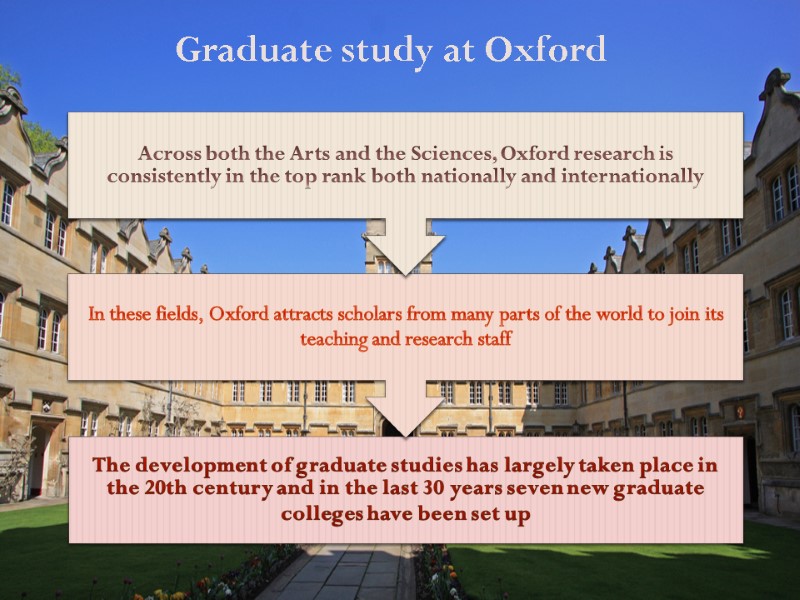
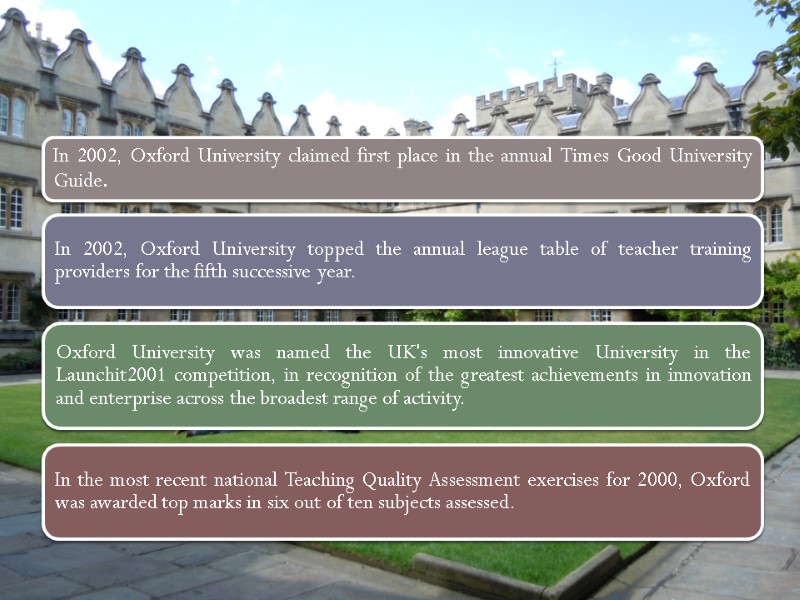
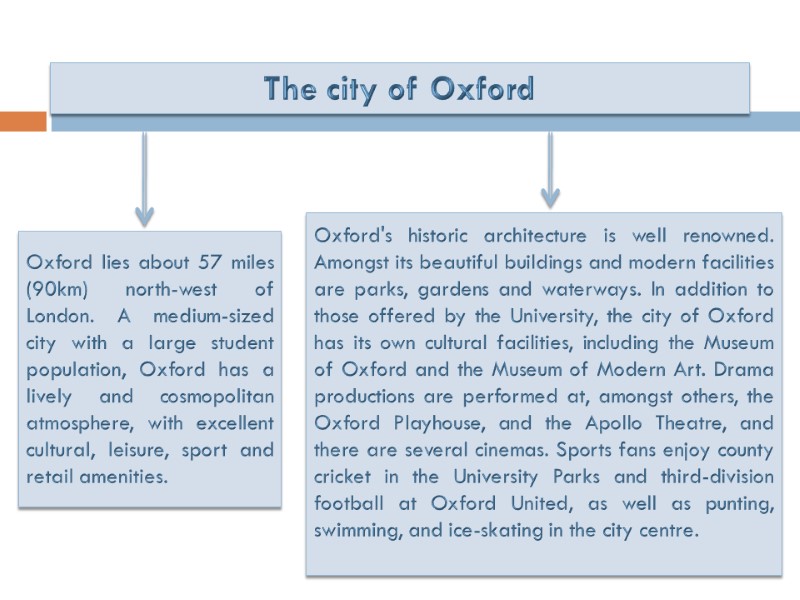
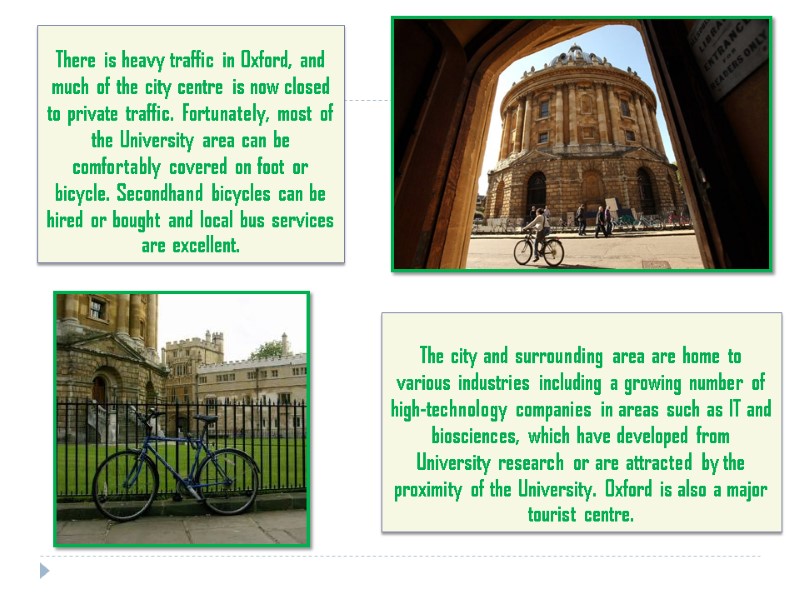
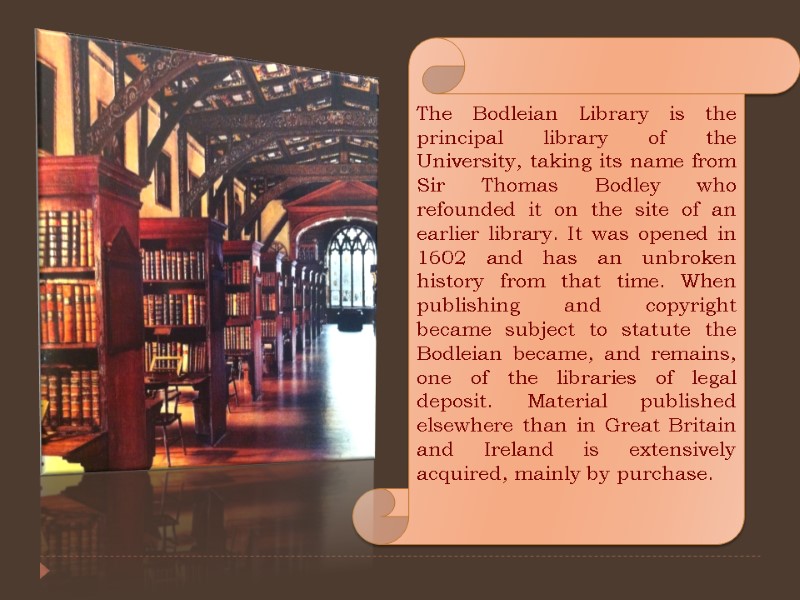
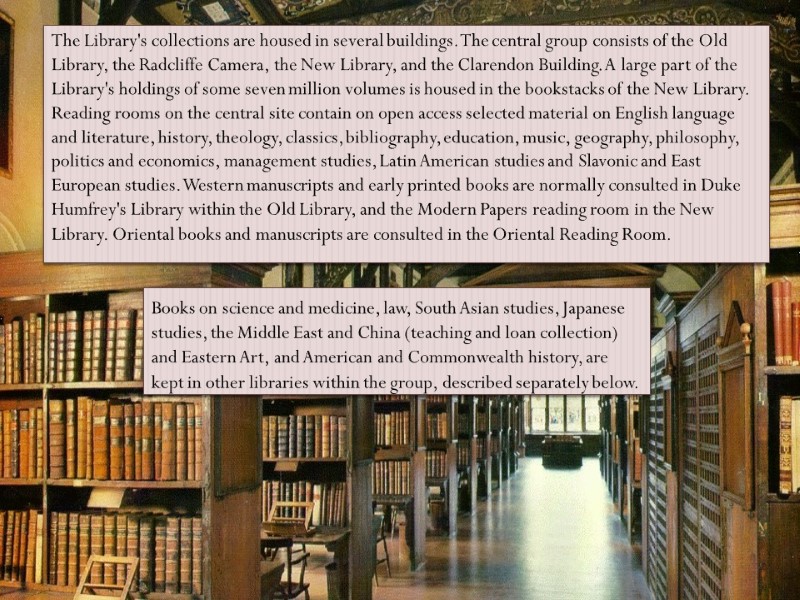
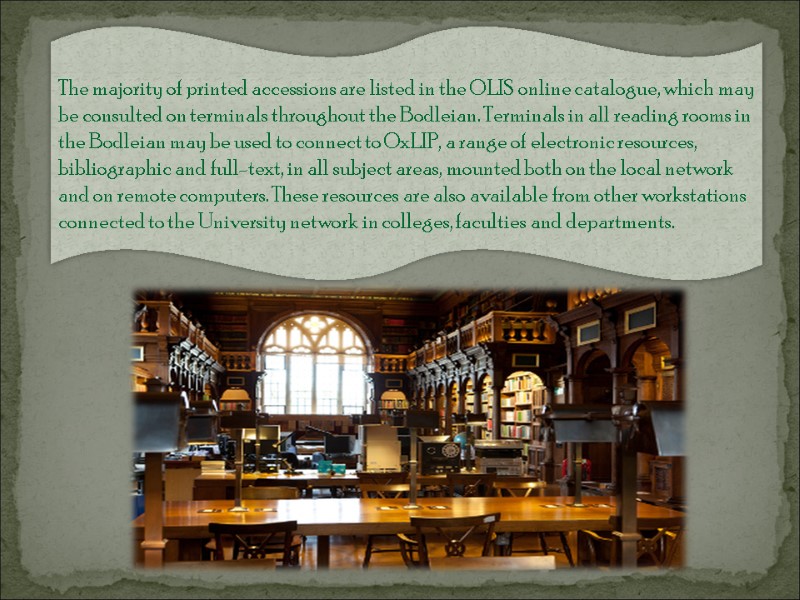
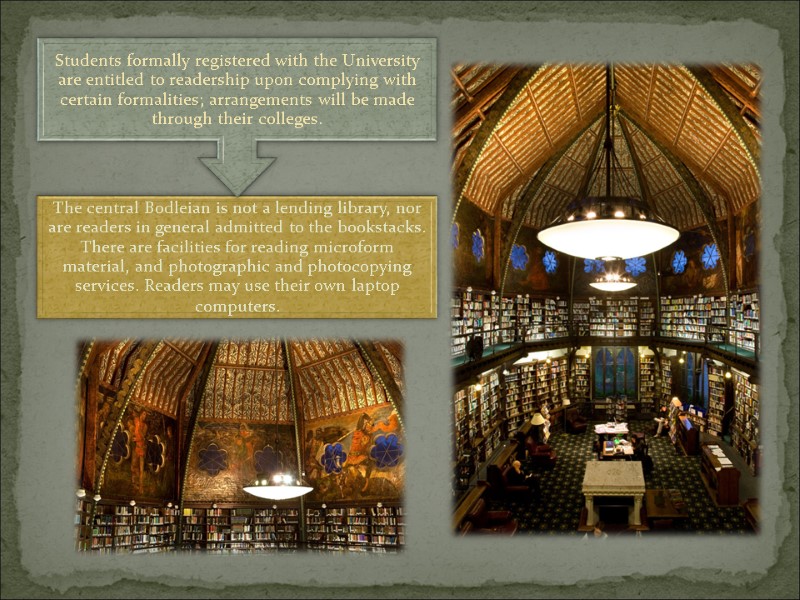
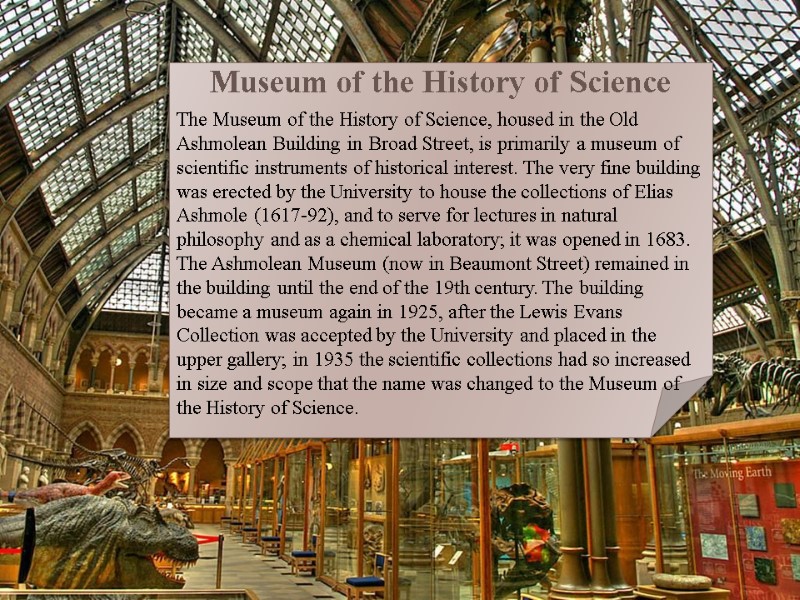
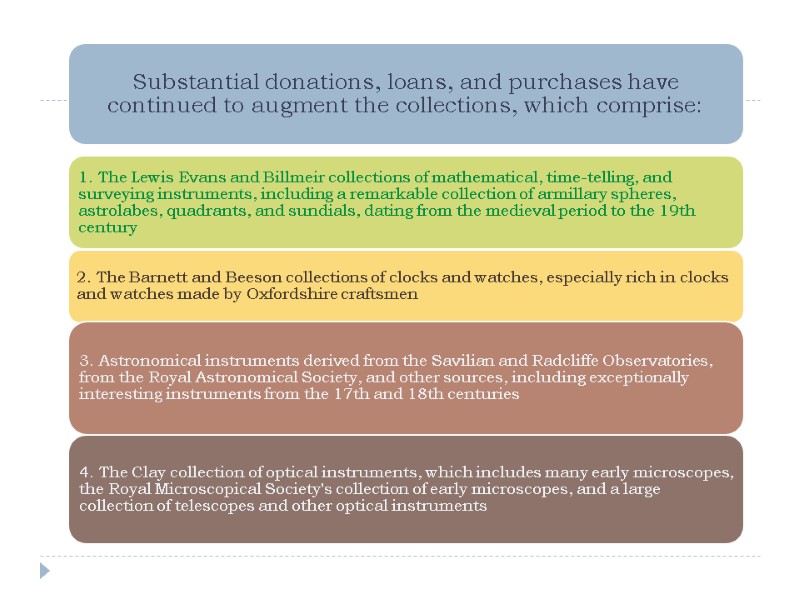
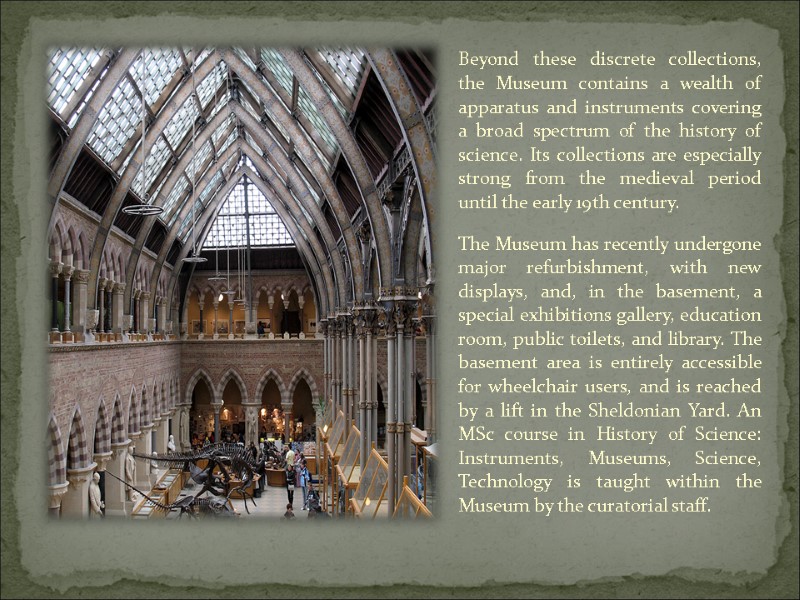

16486-university_of_oxford.ppt
- Количество слайдов: 21
 The University of Oxford
The University of Oxford
 Oxford is a unique and historic institution. As the oldest English-speaking university in the world, it lays claim to eight centuries of continuous existence. There is no clear date of foundation, but teaching existed at Oxford in some form in 1096 and developed rapidly from 1167, when Henry II banned English students from attending the University of Paris.
Oxford is a unique and historic institution. As the oldest English-speaking university in the world, it lays claim to eight centuries of continuous existence. There is no clear date of foundation, but teaching existed at Oxford in some form in 1096 and developed rapidly from 1167, when Henry II banned English students from attending the University of Paris.
 In 1188, the historian, Gerald of Wales, gave a public reading to the assembled Oxford dons and in 1190 the arrival of Emo of Friesland, the first known overseas student, initiated the University's tradition of international scholarship. In the 13th century, rioting between town and gown (students and townspeople) hastened the establishment of primitive halls of residence. Less than a century later, Oxford had achieved eminence above every other seat of learning, and won the praises of popes, kings and sages by virtue of its antiquity, curriculum, doctrine and privileges.
In 1188, the historian, Gerald of Wales, gave a public reading to the assembled Oxford dons and in 1190 the arrival of Emo of Friesland, the first known overseas student, initiated the University's tradition of international scholarship. In the 13th century, rioting between town and gown (students and townspeople) hastened the establishment of primitive halls of residence. Less than a century later, Oxford had achieved eminence above every other seat of learning, and won the praises of popes, kings and sages by virtue of its antiquity, curriculum, doctrine and privileges.
 Oxford early on became a centre for lively controversy, with scholars involved in religious and political disputes.
Oxford early on became a centre for lively controversy, with scholars involved in religious and political disputes.
 In the late 17th century, the Oxford philosopher John Locke, suspected of treason, was forced to flee the country The 18th century, when Oxford was said to have forsaken port for politics, was also an era of scientific discovery and religious revival. Edmund Halley, Professor of Geometry, predicted the return of the comet that bears his name; John and Charles Wesley's prayer meetings laid the foundations of the Methodist Society.
In the late 17th century, the Oxford philosopher John Locke, suspected of treason, was forced to flee the country The 18th century, when Oxford was said to have forsaken port for politics, was also an era of scientific discovery and religious revival. Edmund Halley, Professor of Geometry, predicted the return of the comet that bears his name; John and Charles Wesley's prayer meetings laid the foundations of the Methodist Society.
 The University assumed a leading role in the Victorian era, especially in religious controversy. From 1811 onwards The Oxford Movement sought to revitalise the Catholic aspects of the Anglican Church. One of its leaders, John Henry Newman, became a Roman Catholic in 1845 and was later made a Cardinal. In 1860 the new University Museum was the site of a famous debate between Thomas Huxley, the champion of evolution, and Bishop Wilberforce.
The University assumed a leading role in the Victorian era, especially in religious controversy. From 1811 onwards The Oxford Movement sought to revitalise the Catholic aspects of the Anglican Church. One of its leaders, John Henry Newman, became a Roman Catholic in 1845 and was later made a Cardinal. In 1860 the new University Museum was the site of a famous debate between Thomas Huxley, the champion of evolution, and Bishop Wilberforce.
 From 1878, academic halls were established for women, who became members of the University in 1920. Since 1974, all but one of Oxford's 39 colleges have changed their statutes to admit both men and women. St Hilda's remains the only women's college. In the years since the war, Oxford has added to its humanistic core a major new research capacity in the natural and applied sciences, including medicine. In so doing, it has enhanced and strengthened its traditional role as a focus for learning and a forum for intellectual debate.
From 1878, academic halls were established for women, who became members of the University in 1920. Since 1974, all but one of Oxford's 39 colleges have changed their statutes to admit both men and women. St Hilda's remains the only women's college. In the years since the war, Oxford has added to its humanistic core a major new research capacity in the natural and applied sciences, including medicine. In so doing, it has enhanced and strengthened its traditional role as a focus for learning and a forum for intellectual debate.
 Structure of the University Oxford is an independent and self-governing institution, consisting of the central University and the Colleges.
Structure of the University Oxford is an independent and self-governing institution, consisting of the central University and the Colleges.
 Staff Oxford's current academic community includes 78 Fellows of the Royal Society and 112 Fellows of the British Academy. A further 100 Emeritus and Honorary College Fellows are Fellows of the Royal Society and 145 Emeritus and Honorary College Fellows are also Fellows of the British Academy.
Staff Oxford's current academic community includes 78 Fellows of the Royal Society and 112 Fellows of the British Academy. A further 100 Emeritus and Honorary College Fellows are Fellows of the Royal Society and 145 Emeritus and Honorary College Fellows are also Fellows of the British Academy.
 Graduate study at Oxford
Graduate study at Oxford

 The city of Oxford Oxford's historic architecture is well renowned. Amongst its beautiful buildings and modern facilities are parks, gardens and waterways. In addition to those offered by the University, the city of Oxford has its own cultural facilities, including the Museum of Oxford and the Museum of Modern Art. Drama productions are performed at, amongst others, the Oxford Playhouse, and the Apollo Theatre, and there are several cinemas. Sports fans enjoy county cricket in the University Parks and third-division football at Oxford United, as well as punting, swimming, and ice-skating in the city centre. Oxford lies about 57 miles (90km) north-west of London. A medium-sized city with a large student population, Oxford has a lively and cosmopolitan atmosphere, with excellent cultural, leisure, sport and retail amenities.
The city of Oxford Oxford's historic architecture is well renowned. Amongst its beautiful buildings and modern facilities are parks, gardens and waterways. In addition to those offered by the University, the city of Oxford has its own cultural facilities, including the Museum of Oxford and the Museum of Modern Art. Drama productions are performed at, amongst others, the Oxford Playhouse, and the Apollo Theatre, and there are several cinemas. Sports fans enjoy county cricket in the University Parks and third-division football at Oxford United, as well as punting, swimming, and ice-skating in the city centre. Oxford lies about 57 miles (90km) north-west of London. A medium-sized city with a large student population, Oxford has a lively and cosmopolitan atmosphere, with excellent cultural, leisure, sport and retail amenities.
 The city and surrounding area are home to various industries including a growing number of high-technology companies in areas such as IT and biosciences, which have developed from University research or are attracted by the proximity of the University. Oxford is also a major tourist centre. There is heavy traffic in Oxford, and much of the city centre is now closed to private traffic. Fortunately, most of the University area can be comfortably covered on foot or bicycle. Secondhand bicycles can be hired or bought and local bus services are excellent.
The city and surrounding area are home to various industries including a growing number of high-technology companies in areas such as IT and biosciences, which have developed from University research or are attracted by the proximity of the University. Oxford is also a major tourist centre. There is heavy traffic in Oxford, and much of the city centre is now closed to private traffic. Fortunately, most of the University area can be comfortably covered on foot or bicycle. Secondhand bicycles can be hired or bought and local bus services are excellent.
 The Bodleian Library is the principal library of the University, taking its name from Sir Thomas Bodley who refounded it on the site of an earlier library. It was opened in 1602 and has an unbroken history from that time. When publishing and copyright became subject to statute the Bodleian became, and remains, one of the libraries of legal deposit. Material published elsewhere than in Great Britain and Ireland is extensively acquired, mainly by purchase.
The Bodleian Library is the principal library of the University, taking its name from Sir Thomas Bodley who refounded it on the site of an earlier library. It was opened in 1602 and has an unbroken history from that time. When publishing and copyright became subject to statute the Bodleian became, and remains, one of the libraries of legal deposit. Material published elsewhere than in Great Britain and Ireland is extensively acquired, mainly by purchase.
 The Library's collections are housed in several buildings. The central group consists of the Old Library, the Radcliffe Camera, the New Library, and the Clarendon Building. A large part of the Library's holdings of some seven million volumes is housed in the bookstacks of the New Library. Reading rooms on the central site contain on open access selected material on English language and literature, history, theology, classics, bibliography, education, music, geography, philosophy, politics and economics, management studies, Latin American studies and Slavonic and East European studies. Western manuscripts and early printed books are normally consulted in Duke Humfrey's Library within the Old Library, and the Modern Papers reading room in the New Library. Oriental books and manuscripts are consulted in the Oriental Reading Room. Books on science and medicine, law, South Asian studies, Japanese studies, the Middle East and China (teaching and loan collection) and Eastern Art, and American and Commonwealth history, are kept in other libraries within the group, described separately below.
The Library's collections are housed in several buildings. The central group consists of the Old Library, the Radcliffe Camera, the New Library, and the Clarendon Building. A large part of the Library's holdings of some seven million volumes is housed in the bookstacks of the New Library. Reading rooms on the central site contain on open access selected material on English language and literature, history, theology, classics, bibliography, education, music, geography, philosophy, politics and economics, management studies, Latin American studies and Slavonic and East European studies. Western manuscripts and early printed books are normally consulted in Duke Humfrey's Library within the Old Library, and the Modern Papers reading room in the New Library. Oriental books and manuscripts are consulted in the Oriental Reading Room. Books on science and medicine, law, South Asian studies, Japanese studies, the Middle East and China (teaching and loan collection) and Eastern Art, and American and Commonwealth history, are kept in other libraries within the group, described separately below.
 The majority of printed accessions are listed in the OLIS online catalogue, which may be consulted on terminals throughout the Bodleian. Terminals in all reading rooms in the Bodleian may be used to connect to OxLIP, a range of electronic resources, bibliographic and full-text, in all subject areas, mounted both on the local network and on remote computers. These resources are also available from other workstations connected to the University network in colleges, faculties and departments.
The majority of printed accessions are listed in the OLIS online catalogue, which may be consulted on terminals throughout the Bodleian. Terminals in all reading rooms in the Bodleian may be used to connect to OxLIP, a range of electronic resources, bibliographic and full-text, in all subject areas, mounted both on the local network and on remote computers. These resources are also available from other workstations connected to the University network in colleges, faculties and departments.

 The Museum of the History of Science, housed in the Old Ashmolean Building in Broad Street, is primarily a museum of scientific instruments of historical interest. The very fine building was erected by the University to house the collections of Elias Ashmole (1617-92), and to serve for lectures in natural philosophy and as a chemical laboratory; it was opened in 1683. The Ashmolean Museum (now in Beaumont Street) remained in the building until the end of the 19th century. The building became a museum again in 1925, after the Lewis Evans Collection was accepted by the University and placed in the upper gallery; in 1935 the scientific collections had so increased in size and scope that the name was changed to the Museum of the History of Science. Museum of the History of Science
The Museum of the History of Science, housed in the Old Ashmolean Building in Broad Street, is primarily a museum of scientific instruments of historical interest. The very fine building was erected by the University to house the collections of Elias Ashmole (1617-92), and to serve for lectures in natural philosophy and as a chemical laboratory; it was opened in 1683. The Ashmolean Museum (now in Beaumont Street) remained in the building until the end of the 19th century. The building became a museum again in 1925, after the Lewis Evans Collection was accepted by the University and placed in the upper gallery; in 1935 the scientific collections had so increased in size and scope that the name was changed to the Museum of the History of Science. Museum of the History of Science

 Beyond these discrete collections, the Museum contains a wealth of apparatus and instruments covering a broad spectrum of the history of science. Its collections are especially strong from the medieval period until the early 19th century. The Museum has recently undergone major refurbishment, with new displays, and, in the basement, a special exhibitions gallery, education room, public toilets, and library. The basement area is entirely accessible for wheelchair users, and is reached by a lift in the Sheldonian Yard. An MSc course in History of Science: Instruments, Museums, Science, Technology is taught within the Museum by the curatorial staff.
Beyond these discrete collections, the Museum contains a wealth of apparatus and instruments covering a broad spectrum of the history of science. Its collections are especially strong from the medieval period until the early 19th century. The Museum has recently undergone major refurbishment, with new displays, and, in the basement, a special exhibitions gallery, education room, public toilets, and library. The basement area is entirely accessible for wheelchair users, and is reached by a lift in the Sheldonian Yard. An MSc course in History of Science: Instruments, Museums, Science, Technology is taught within the Museum by the curatorial staff.
 Thank you for your attention!
Thank you for your attention!
